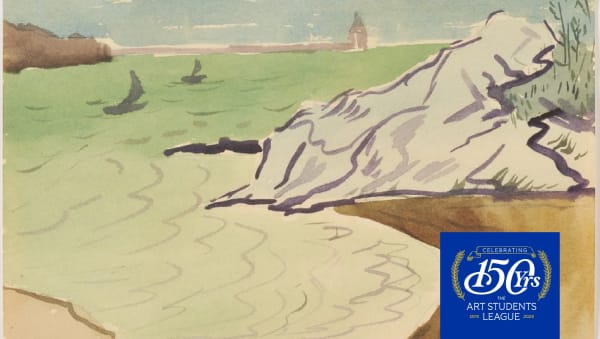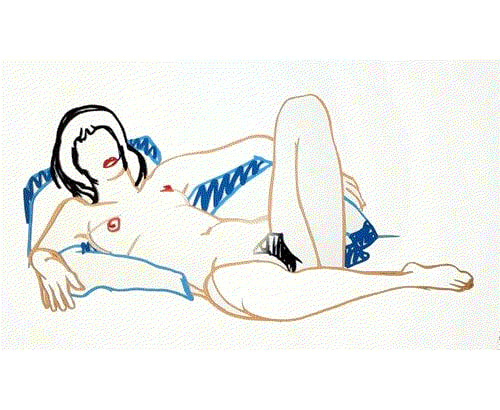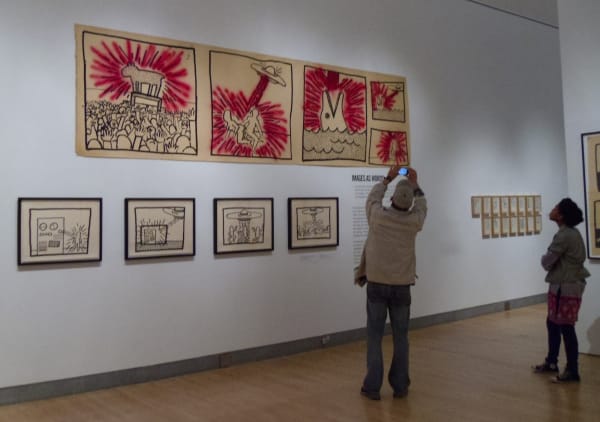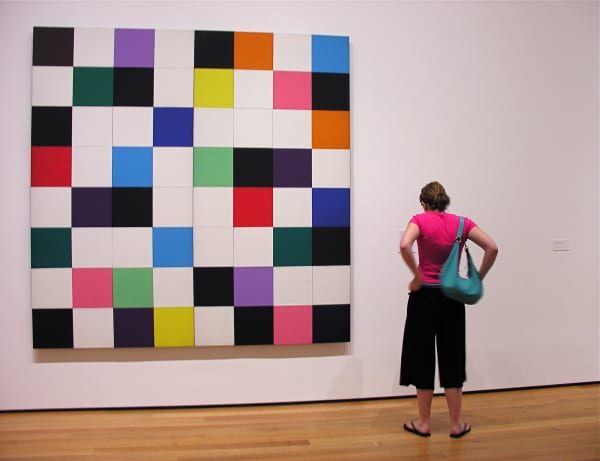James Rosenquist
James Rosenquist was one of America’s most influential Pop artists, known for his enormous compositions relating to consumerism, politics and science.
Early Life and Education
James Rosenquist was born in Grand Forks, North Dakota in 1933 to parents of Scandinavian descent. The family moved often, his father working at a series of jobs in the aviation industry. Rosenquist’s mother was a pilot and amateur painter, who encouraged Rosenquist’s artistic talents.
The family moved to Minneapolis when Rosenquist was eleven. He won a scholarship in junior high school for four Saturdays of art classes at the Minneapolis School of Art, attended the Minneapolis Institute of Arts, graduated from high school and went on to study art at the University of Minnesota.
After leaving the University of Minnesota with an associate’s degree in studio art, Rosenquist painted billboards in Minneapolis and Saint Paul for the General Outdoor Advertising company.
In 1955, Rosenquist got a scholarship to the Art Students League in New York, where he studied for a year. He earned money by painting billboards and, in his spare time, attended drawing classes with Claes Oldenburg and Henry Pearson.
Career
In 1960, Rosenquist quit his work as a billboard painter, after two fellow painters fell from scaffolding and died. He rented a studio at 3–5 Coenties Slip, near the workspaces of Robert Indiana, Ellsworth Kelly, and Jack Youngerman, and committed himself to a career in fine art.
He had his first solo exhibitions at the Green Gallery in 1962, but it was his enormous F-111 painting at the Leo Castelli Gallery in 1965 that propelled his career.
Rosenquist began to get commissions and the focus of his work began to change from a focus on pop culture to politics and the relationship between art and science. Rosenquist was appointed to National Council on the Arts soon after he lobbied, as an influential artist, for federal protection of artists’ rights during the 1970s. Besides creating large, paint and collage murals, Rosenquist was a skilled printmaker and designer.
Personal Life
Rosenquist married textile designer, Mary Lou Adams, in 1960. The couple had a son, John. The marriage ended in divorce in 1975. He married his second wife, Mimi Thompson in 1987, and they had one child, a daughter, Lily. In 1976, Rosenquist bought land in Aripeka, Florida, and built a home and studio on the property. He traveled between his studio in Manhattan and his studio in Florida for more than thirty years.
In 2009, a suspicious fire destroyed Rosenquist’s home, studio, office and other buildings and consumed 62 acres of his property. Among the works the artist said he lost was a mural commissioned by the government of France that measured 133 feet high by 24 feet wide. James Rosenquist died in New York on March 17, 2017, at age 83. Both the Museum of Modern Art in New York and the University of South Florida Contemporary Art Museum in Tampa held memorial services to honor him.
Legacy
James Rosenquist’s work is part of the permanent collections in major public and private institutions, and has been featured in solo exhibitions at the Solomon R. Guggenheim Museum, Museum of Modern Art, Walker Art Center, Whitney Museum of American Art, Guggenheim Museum Bilbao, The Menil Collection, The Museum of Fine Arts Houston, Denver Art Museum, Tretyakov Gallery, Museum Ludwig, Wallraf-Richartz Museum, and other national and international institutions.
Send me more information on James Rosenquist
-

The Art Students League Celebrates 150th Anniversary
A Special Tribute to Robert Rauschenberg at the Art Students League Gala September 18, 2025The Art Students League is celebrating its 150th anniversary this year. Since 1875 great artists have walked through the doors of 215 West 57th Street...Read more -

The Art Students League Celebrates 150 Years
Showcased works by Milton Avery, Adolph Gottlieb and other Art Students League Alumni June 20, 2025The Art Students League of New York is celebrating its 150th anniversary with an exhibition of works by many of its most talented artists. The...Read more -

Fine Art Print Week in New York
Fine Art Prints at Surovek Gallery March 28, 2025An etching is a conversation between artist and plate. - Rembrandt van Rijn Printmaking is controlled accident. - Robert Rauschenberg It’s Print Week in New...Read more -

Tom Wesselmann Retrospective in Paris
December 12, 2024Tom Wesselmann (1931-2004) began his career as a cartoonist and illustrator for men’s magazines. It was after he left his home in Cincinnati and moved...Read more -

Andy Warhol's Tributes to the Famous
Wolf Kahn Remembered October 18, 2024The best thing about a picture is that it never changes, even when the people in it do. —Andy Warhol A few weeks ago, a...Read more -

Robert Rauschenberg's Works in New York and California
October 10, 2024Artists drag other parts of society into a confrontation with the unknown. - Robert Rauschenberg Works by Robert Rauschenberg (1925-2008) are currently on exhibit at...Read more -

Andy Warhol & Keith Haring. Party of Life in Munich
October 3, 2024'Andy's life and work made my work possible. Andy set the precedent for the possibility for my art to exist. He was the first real...Read more -

Surovek Gallery at Art Miami 2023
November 30, 2023At Surovek Gallery our focus is on the finest American paintings, drawings, watercolors and prints of the 19th, 20th and 21st centuries; the oeuvre which...Read more -

Tom Wesselmann's Steel Cut Drawings
May 25, 2023In 1983, Tom Wesselman wanted to reduce his drawings to their most basic lines, not with paint, but with steel. He wanted them to feel...Read more -

Frank Stella's Day Job, Rapper Drake Restores Luna Luna Art Park
March 10, 2023Frank Stella ’s father emigrated from Italy and worked as a house painter to put himself through medical school to become a gynecologist. Stella worked...Read more -

James Rosenquist: Flowers and Females
June 22, 2021James Rosenquist 1933-2017 I'm the one who gave steroids to Pop art. – James Rosenquist James Rosenquist's work combines Pop and Surrealist images. His background...Read more -

Picasso and Warhol in Beijing
October 6, 2020Pablo Picasso and Andy Warhol in Beijing Art lovers in Beijing flocked to the UCCA Center for Contemporary art last summer to view a retrospective...Read more -

Works of the Artists of Coenties Slip
July 22, 2020In the 1950s a group of young artists, who had a lot of talent, an abundance of passion but not much money, settled into the...Read more














